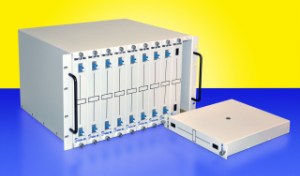It is well known that fiber optics are at the heart of data-focused industries such as telecommunications, cable, and enterprise networking. But fiber optic technology also plays a critical role for utility providers such as electric, gas, and water. Simulating the network and testing for latency are keys to successfully deploying fiber networks in the utilities industry.
Water utilities and municipalities are upgrading outdated transmission systems to fiber. Natural gas providers are using fiber optics to monitor pipelines in real-time. Electric utilities have been using fiber optic technology for more than 30 years to help manage the grid. Fiber has played a role in areas such as measuring current and voltage along with other monitoring and controls. For electric utilities in particular, the advent of alternative energy has required an expansion to the grid along with the fiber network supporting it. Given the critical role that fiber optics play to ensuring predictable, reliable, and secure electric, water, and gas service, ensuring the network performs as specified is a high priority.
For a utility, before making a large investment in time, resources and equipment, it is critical that they simulate fiber network links and latency in advance to ensure the optical devices and systems will perform as expected. Since these tests are typically performed in the lab, the best practice is to use similar lengths of the same type of optical fiber that is (or will be) deployed in the field. Taking this approach certifies that the performance results generated in the lab will closely and accurately replicate those in the field network.
 |
Fiber Lab Flex - Link and Delay Simulator |
M2 Optics is unique in our ability to provide utilities with not only the fiber needed, but in a compact and organized setup that accurately replicates the field network. As an example, a utility may need to certify a new device before bringing it into service. While the device manufacturer has provided specifications and test results from their lab, their test setup likely does not exactly mimic that of the utility’s network links and conditions. While the device vendor may have an excellent and well-tested device, leveraging M2 Optics customized network simulation solutions as part of a broad test protocol can help the utility to ensure the device is the best match for their unique network environment.
Another example is that often a utility will need to connect two base centers with optical fiber. This new link requires testing of the expected latency for that unique distance using the selected fiber. Offering optical fiber spools customized to the specified link length, M2 Optics solutions provide a more accurate one-way or round-trip latency value than using standard lengths that may come from the fiber manufacturer or an alternative approach entirely.
Fiber optic technology has been a game-changer for utilities. More data is transmitted faster than traditional technologies ever could, opening opportunities to measure more details about the grid. This improves not only the availability of data but also the ability to manage and act upon any exceptions in the system.
Water, electricity, and natural gas are critical to homes in the United States and reliable fiber optic networks assure reliable grids. For utility engineering teams seeking to ensure that the fiber-based systems being deployed will both meet the required specifications and operate within expected parameters, M2 Optics is the right partner to support these efforts.





